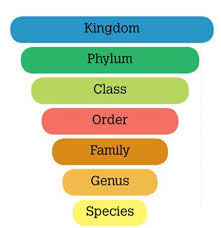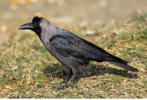Science > Biology > General Biology > Diversity of Living Organisms > Taxonomic Hierarchy
In this article, we shall study the taxonomic hierarchy and the concept of species.
The Concept of Species:
A group of living organisms consisting of similar individuals capable of exchanging genes or interbreeding is called species. They are usually described in terms of their characteristics so that organisms which have a lot of similarities are grouped as the same species.
Characteristics of Species:
- Members of species resemble one another more than with individuals of any other species.
- Their morphological characters are similar.
- They interbreed with other individuals within the same group to produce fertile offsprings
- under natural conditions.
- They share a common gene pool. Have similar karyotype and genetic material. They have descended from a common ancestor.
- They are anatomically similar.
- Their biochemistry is similar.
Taxonomic Hierarchy:
- Taxon (Pl – taxa): Taxon is a group of living organisms which is used to represent a concrete unit of classification. It may be large or small. In a taxonomic hierarchy, there are a minimum of seven categories (taxa). Various taxonomic categories are species, genus, family, order, class, phylum, kingdom, and domain.
- Category: A category is a rank or level in the hierarchical classification of organisms. In the hierarchy of categories, the kingdom is the highest and species is the lowest category.
Units of Classification:
Acronym: King Philip’s’s Classmates Sing a Song Of Family Genius Specially

Species:
It is the smallest and basic unit of classification. Taxonomic studies consider a group of individual organisms with fundamental similarities as a species. Thus all the individual members belonging to particular species show all similar characters and can breed among themselves to produce a similar type of organism. We should be able to distinguish one species from the other closely related species based on the distinct morphological differences. All the china rose (Hibiscus) plants are grouped under a species rosa Sinensis. All the potato plants are grouped under species tuberosum.
- House crow commonly called the Indian crow (Corvus splendens) and forest crow commonly called jungle crow or raven (Corvus macrorhynchos) have the same genus but they can not breed among themselves. Hence these are two different species.


- Horse (Equus cabalus) and ass (Equus asinus) are of the same genera but are two different species because they do not breed among themselves. The mule is an artificial hybrid of horse and ass is sterile i.e. it cannot reproduce. Hence the mule is not a species.

- Lion (Panthera leo), Leopard (Panthera pardas) and Tiger (Panthera tigris) belong to the same genus Panthera but their species are leo, pardas and tigris respectively.
- The plants Tomato (Solanum lycopersicum), Potato (Solanum tuberosum) and Brinjal (Solanum melongena) belong to the same genus Solanum but their species are lycopersicum, tuberosum, and melongena respectively.
Genus (Pl – genera):
It is a group of organisms of closely related species, which resemble one another in certain characters. The genus may or may not have more than one species. Genera with only one species are called monotypic while those with more than two are called polytypic.
- Banyan tree (Ficus benghalensis) and fig tree (Ficus carica) differ in shape, size, leaves but have a similar reproductive organ like inflorescence. Hence they are of the same genera.
- Lion (Panthera leo), Leopard (Panthera pardas) and Tiger (Panthera tigris) belong to the same genus Panthera. Genus Panthera is different from other genera of cats. Domestic cat and tiger belong to the same family but their genera are different.
- The plants Tomato (Solanum lycopersicum), Potato (Solanum tuberosum) and Brinjal (Solanum melongena) belong to the same genus Solanum.
Family:
It is the next category higher to the genus. It is a group of organisms of closely related genera, which resemble one another in certain characters.

- Domestic cat (Felis domestica) and Lio (Panthera leo) belong to cat family Felidae because both of them possess a similar structure and has retractive claws.
- The family of Dogs and Foxes is Canidae.
- Family Gramineae: Wheat, Rice, and maize.
- Family Leguminosae: Gram, Pea, Soyabean
- Family Solanaceae: Genera Solanum, Petunia, Datura
Order:
It is next category higher to the family. It is a group of organisms of closely related families, which resemble one another in major characters. It should be noted that the order is higher taxonomic categories. Hence very few similar characters are shown by members.
- Both the tiger (Panthera tigris) and the wolf (Cannis lupus) possess jaws with powerful incisors and large sharp canines. This adaptation is for flesh-eating. Hence tiger and wolf have the same order Carnivora. Thus Order Carnivora includes families Felidae and Canidae.
- In plant, order, Rosales includes families Leguminosae and Rosaceae.
Class:
It is the next category higher to the order. It is a group of organisms of closely related sub-classes or order, which resemble one another in certain characters. The similarities in the orders of a class are still less than in the families of an order.
- Chordates such as rats, dogs, bats, monkeys, camel are characterized by a hairy exoskeleton, milk glands (mammari glands)and external ears, belong to the same class Mammalia. Class Mammalia includes order Carnivora (has carnivorous animals like lion, tiger, leopards, etc.) and order Primata (includes man, monkey, Chimpanzee, Gorilla, Gibbons, etc)
- All vascular plants are categorized under class Tracheophyta.
Phylum (for animals) and Division (for plants):
It is the next category higher to the class. It is a group of organisms of closely related class, which resemble one another in certain characters. In the case of plants, the term Division is used for the phylum
- all animals which have a notochord present in embryo belong to the phylum Chordata. Classes like Pisces (fishes), Amphibia (frogs and toads), Reptilia (snakes and lizards), Aves (birds) and Mammalia (mammals) are all grouped into a single phylum Chordata.
- All flowering plants are grouped into a single division Angiosperms.
Kingdom:
It is the next category higher to the phylum/division. It is a group of organisms of closely related phyla, which resemble one another in major characters. All animals are grouped into Kingdom Animalia and all plants are grouped into Kingdom Plantae.
2 replies on “Taxonomic Hierarchy”
Thanks. This really enlightened me. However I think the acronym for the hierarchy would be King Philip Comes Over From Good Spain ⟵(o_O)
This I have learnt enough